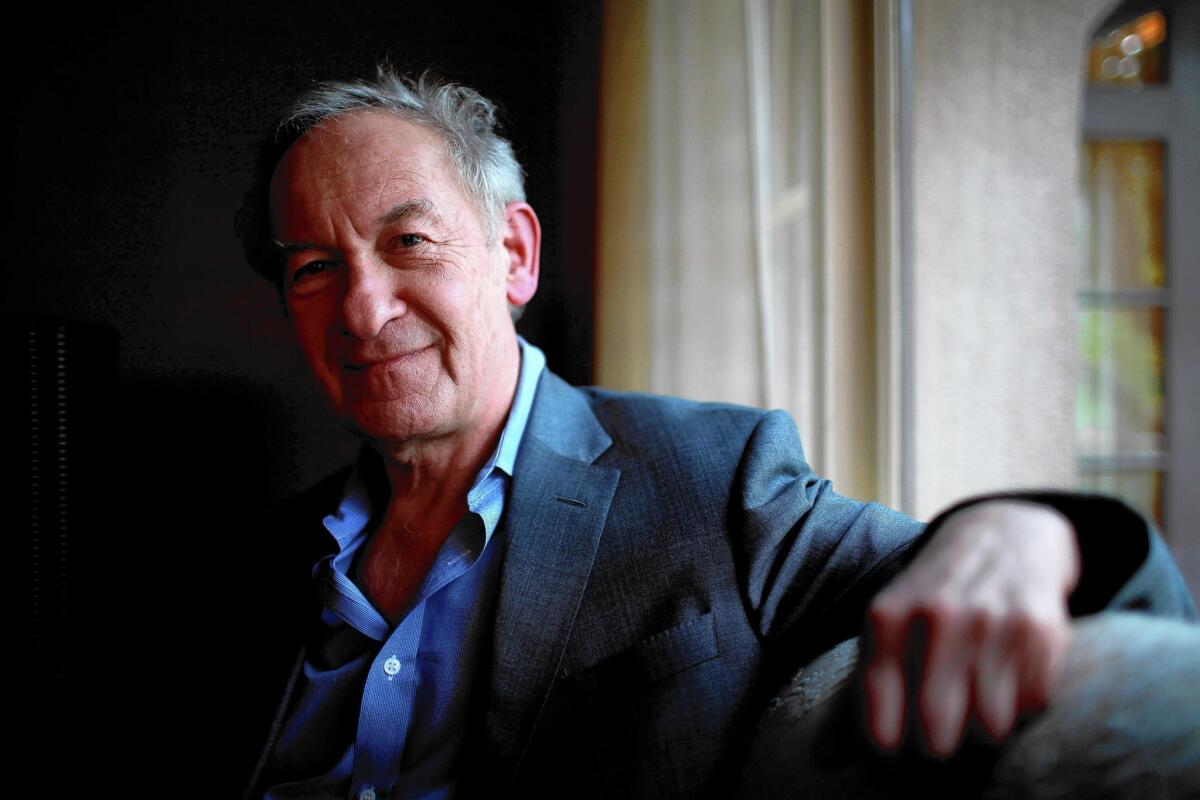Simon Schama takes on a big topic: the history of the Jews

When telling a tale that includes centuries of endurance, moments of triumph, bursts of humor and sudden, unspeakable atrocities, what’s the right tone with which to articulate it all?
That’s the trick historian Simon Schama had to figure out in his new documentary, “The Story of the Jews,” which begins in the Middle Eastern desert about 3,000 years ago and tracks up to the more-or-less present. The program, in five hourlong parts, broadcasts on PBS on Tuesday and April 1.
“I wanted to say, without putting on a ridiculous smiley face or making light of the tragic aspects, that there is a story to be told beyond one clearly framed by the assumption of catastrophe,” the British historian said in Pasadena. “No one’s going to accuse me of doing this program as light entertainment.”
BEST MOVIES OF 2013: Turan | Sharkey | Olsen
It means, for Schama, looking squarely at early Jewish persecution in the Holy Land, Russian pogroms and the Holocaust as well as the moments when things worked between Jews and those they lived among and the bright and sensuous and funny expressions of Jewish culture that blossomed along the way.
Schama, who’s written extensively about visual art, is especially interested in places where he sees dramatic and unexpected cultural blendings: Spanish stucco work made by Jews but drawing from the Islamic tradition or Jewish mosaics in Tunisia that extend the imagery of the classical world. It reminds him of the measures of harmony sometimes overlooked.
“There are moving, powerful, upsetting moments in the later programs in particular,” he says. “But they do not dominate.”
PHOTOS: Billion-dollar movie club
The documentary’s governing notion seems to be that despite huge differences in complexion, religion, music, food, geography and so on, the Jewish people still have a few things in common. Thousands of years of Jewish history — and that the term “Jewish” refers to both a religion and an ethnic group — means an especially wide range. Sigmund Freud was a German-speaking atheist living in London near the end of his life but considered himself profoundly Jewish.
As Schama says in the program’s opening episode, “What ties us together is a story, a story kept in our heads and hearts, a story of suffering and resilience, endurance and creativity. It’s the story that made me want to be a historian in the first place.” In short, “we told our story to survive — we are our story.”
And despite his attempt to look at brighter moments, he can’t escape a kind of gallows humor that may be woven as deeply into Jewish identity as storytelling. “Is Jewish culture,” he asks in the first episode, “always about expecting the worst?”
Back to Abraham
The story of the Jews goes back something like 4,000 years, to the patriarch Abraham seeking the promised land and a covenant with his god. “The Story of the Jews With Simon Schama” — the program’s full title — has a more conventional origin: The historian, whose best-known work includes the Emmy-winning film “The Power of Art” and the 15-part documentary “The History of Britain,” was asked by the BBC to take on the project. Despite his long-standing cultural connections — he’s not especially religious — Schama had not written extensively about Jewish topics for almost four decades. It seemed time to jump in.
The ensuing program, which aired on Britain’s BBC2 last September, was a popular and critical hit; the Observer’s Andrew Anthony called it “an astonishing achievement, a TV landmark.” An accompanying book, “The Story of the Jews: Finding the Words 1000 BC-1492 AD” — came out in Britain last year and this month here; a sequel, “When Words Fail: 1492-Present,” will appear in the fall.
With thousands of years of history over five hours, Schama and crew chose to concentrate on broad themes. The first episode, “In the Beginning,” looks at the emergence of the Jewish tribe, its earliest rituals and wanderings, the importance of the Torah, and the Roman destruction of the Jerusalem Temple. Some of this episode was inspired by material Schama found at the Brooklyn Museum about a Jewish community on an island in the Nile: It showed him that the culture, even early on, often thrived in exile.
“These are Jews asking their correspondents in Jerusalem about which day to celebrate Passover, but they’re living in Egypt, with no intention of going anywhere else. They’re living lives of wonderful suburban banality: They’re not creating philosophy or commenting on the Bible, but koshering up [converting] slave girls and having bling-y weddings,” he says.
GRAPHIC: Faces to watch 2014 | Entertainment
The second episode chronicles Jews’ further moving out of their traditional Levantine homeland, into territory ruled by Muslim and Christians, including medieval Spain, for a while the site of peaceful coexistence until their expulsion by Ferdinand and Isabella. The third episode describes another of those moments of promise, in which 18th century German-speaking Europe opened its door a bit to the Jewish people; this ended as badly as it had in Spain.
The fourth episode, “Over the Rainbow,” concerns the road from the Eastern European shtetl to New York’s Lower East Side and Hollywood. “Return,” the final episode, looks primarily at the Holocaust, Israel and the complicated state of Jewish identity today.
Part of what Schama tries to do is draw connections from various times and places, to show the Jewish story’s through line. He sees it, for example, in the Depression-era show tune “Brother, Can You Spare a Dime?” — written by two Jewish songwriters, Yip Harburg and Jay Gorney, and so influential that it may have helped ensure the election of Franklin Delano Roosevelt as president.
“The Republicans wanted to have it banned,” Schama says. “When those six guys came onstage in their shirt sleeves, people got up and shouted themselves hoarse. That to me was the perfect [symbol] for what was transplanted from Odessa and the shtetls, the wish to speak in music and dance, to connect with the world of politics and society — something lighthearted and deeply serious at the same time.”
How history is told
There was a time, not too long ago, when a serious historian — Schama was trained at Cambridge University and now teaches at Columbia — might hesitate to go on television. He’s still a bit of an outlier. “Loud, passionate, ambitious and above all visible,” Anthony noted in the Observer, “Schama is the antithesis of the ivory tower academic. He has no truck with secluded contemplation. Instead, he thrives on debate, noise and, most of all, people.”
Schama, an enthusiastic talker who in person vaguely resembles Ian McKellen, recalls it this way: “When I went to Cambridge as an undergraduate, there was a kind of War of the Roses, almost. One side said, ‘To be an historian means attending only to the archive, cutting yourself off from the crude popular historian — Trevelyan, Barbara Tuchman and so on. My tutor, J.H. Plumb, was exactly the opposite. He said, ‘Remember, Herodotus was shouting in the marketplace, not only for professional historians, but for the people of Athens.’ He said, ‘Not only are they not mutually exclusive, scholarly pursuits and communicating to everyone else, but they necessarily nourish each other.’” Schama also admires the British scholar Jacob Bronowksi, whose 1973 BBC documentary “The Ascent of Man” helped inspire Carl Sagan’s original “Cosmos.”
This sensibility — as well as the BBC money that funds much of the best work — has brought us to a place where historical documentaries are thriving in both Britain and the States, says Vincent Brook, a UCLA film and television historian. These days, he sees two approaches: the “anonymous, disembodied, voice-of-God voice-over,” which associates with “the Ken Burns burnout,” as well as a more subjective kind of history, narrated by a charismatic on-camera historian who sometimes has a personal connection to the story.
A handful of historians — Schama and Henry Louis Gates of Harvard among them — have brought this second style to a high level, Brook says. This more subjective style, he says, “goes to the idea of history itself — how objective is it?” Brook points out that we’ve increasingly turning to history in our narratives: Most of the recent best-picture nominees concerned historical scenarios. “As we recede from a singular idea of history, with no absolute truth but multiple truths, there’s an obsession with grappling with any truth we can get.”
SNEAKS: Movie trailers, full coverage
And now the U.S.
The stateside reception of “The Story of the Jews” is hard to predict: American popular culture is shaped more significantly by Jews than its British equivalent, and Jewish history is better known here than there. To some, the tale may be too familiar.
Even the early Hebrew tribes valued narrative and literacy, which means that much of this story has been told for milleniums. “We are going to write the enemy into capitulation!” Schama jokes in the book. “Surrender to our verbosity or else!”
But the historian says his most important role is to tell the tale to those who don’t know much of it, since ignorance often leads to suspicion and paranoia.
“We’ve had 5,000 years of misunderstanding, massacre and persecution,” he says.
The old medieval myths — that Jews run an international financial conspiracy, for instance — are back with a vengeance. Part of his job with the documentary, he says, is beating back that sort of misinformation, which has been revived by the Internet. “More people than ever are reading the ‘Protocols of the Elders of Zion’ because of the Web.”
Despite good reviews, he knows plenty of people, Jewish and otherwise, will not be satisfied with his way of telling this long story. Writing about the program for the British newspaper Metro, he invoked an old joke. “A waiter goes over to two elderly Jewish ladies eating in a restaurant and nervously says: ‘Is anything all right?’ I pretty much expect nothing will be all right.”
-----------------------
‘Story of the Jews With Simon Schama’
Where: KOCE
When: 8 and 9 p.m. Tuesday
Rating: TV-PG (may be unsuitable for young children)
More to Read
The complete guide to home viewing
Get Screen Gab for everything about the TV shows and streaming movies everyone’s talking about.
You may occasionally receive promotional content from the Los Angeles Times.






